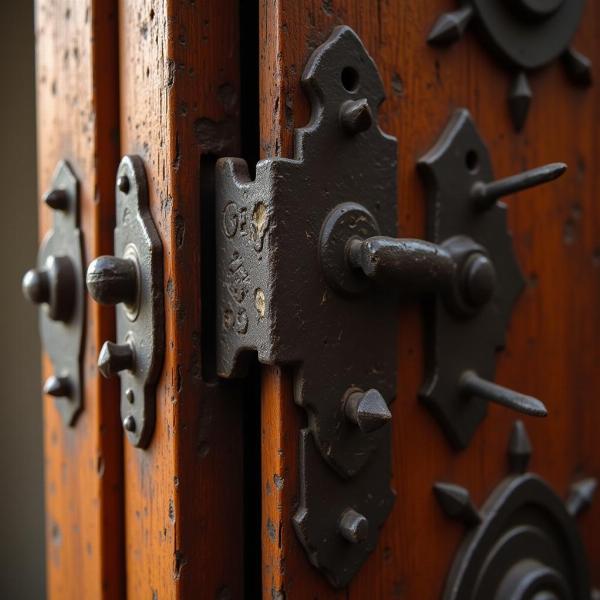Understanding the meaning of “iron nails” in Hindi is crucial for anyone working with construction, hardware, or even just everyday conversations. While a simple translation might suffice in some cases, grasping the cultural and contextual nuances associated with the term enriches communication and avoids misunderstandings. This article explores the various Hindi words for “iron nails,” their usage in different contexts, and associated cultural significance.
Decoding “Iron Nails” in Hindi: लोहे की कीलें (Lohe Ki Keelen) and Beyond
The most common and straightforward translation of “iron nails” in Hindi is लोहे की कीलें (lohe ki keelen). लोहा (loha) means “iron,” and कील (keel) means “nail.” The word की (ki) acts as a possessive marker, connecting “iron” and “nails.” This phrase is widely understood across Hindi-speaking regions. However, other terms and variations exist depending on the specific type of nail, its purpose, and the regional dialect.
For instance, a small nail might be referred to as a छोटी कील (chhoti keel), while a large nail could be called a बड़ी कील (badi keel). Specific types of nails, like a tack, might be called a पिन (pin) or a ठोकरी (thokri). Understanding these subtle differences is vital for accurate communication.
Uses of Iron Nails in India: From Construction to Crafts
Iron nails play a vital role in various aspects of Indian life, from large-scale construction projects to intricate handicrafts. In construction, they are essential for joining wooden structures, securing roofing materials, and reinforcing furniture. Their durability and strength make them indispensable in building homes, temples, and other structures.
Beyond construction, iron nails find their way into traditional crafts like carpet weaving and embroidery. They are used to secure the warp threads on looms and create intricate patterns in textiles. Even in everyday life, iron nails are used for hanging pictures, securing household items, and various other purposes.
Cultural Significance and Idiomatic Expressions
In some Indian cultures, iron nails are associated with protection and warding off evil spirits. They are sometimes hammered into doorways or thresholds to safeguard the home. This practice reflects the belief that iron possesses a certain power to repel negativity.
 Cultural Significance of Iron Nails
Cultural Significance of Iron Nails
Furthermore, the term “iron nail” features in several Hindi idioms and proverbs. For example, the phrase “लोहे के चने चबाना” (lohe ke chane chabana), which literally translates to “chewing iron chickpeas,” means to tackle a difficult task. This expression highlights the strength and resilience associated with iron.
Finding the Right “Iron Nail” Word: Context is Key
Ultimately, choosing the most appropriate Hindi word for “iron nail” depends heavily on the specific context. Consider the type of nail, its size, its purpose, and the regional dialect of your audience. Using precise terminology demonstrates cultural sensitivity and ensures effective communication.
Conclusion
While लोहे की कीलें (lohe ki keelen) serves as the general translation for “iron nails” in Hindi, understanding the nuances of related terms and their cultural significance is crucial for accurate and meaningful communication. This article has explored the various words for “iron nails,” their usage, and their place in Indian culture. By grasping these subtleties, you can navigate conversations with confidence and avoid misunderstandings.
FAQ
- What is the most common Hindi word for “iron nails”? The most common word is लोहे की कीलें (lohe ki keelen).
- Are there different words for different types of nails in Hindi? Yes, there are variations like छोटी कील (chhoti keel) for a small nail and बड़ी कील (badi keel) for a large nail.
- What is the cultural significance of iron nails in India? In some cultures, they are believed to ward off evil spirits and are used in protective rituals.
- Are there any idioms or proverbs related to “iron nails” in Hindi? Yes, phrases like “लोहे के चने चबाना” (lohe ke chane chabana) use the imagery of iron nails to denote tackling difficult tasks.
- Why is it important to understand the context when translating “iron nails” to Hindi? Context helps you choose the most precise and culturally appropriate term.
Related Articles
Meaning-Hindi.in is your premier destination for professional Hindi translation services. Specializing in business, legal, technical, website localization, and educational document translation, we offer accurate and culturally sensitive translations to bridge the communication gap. Whether you need quick translations or specialized industry expertise, our team is here to help. Contact us today at [email protected] or +91 11-4502-7584. Meaning-Hindi.in is committed to delivering high-quality translations that meet your unique needs.